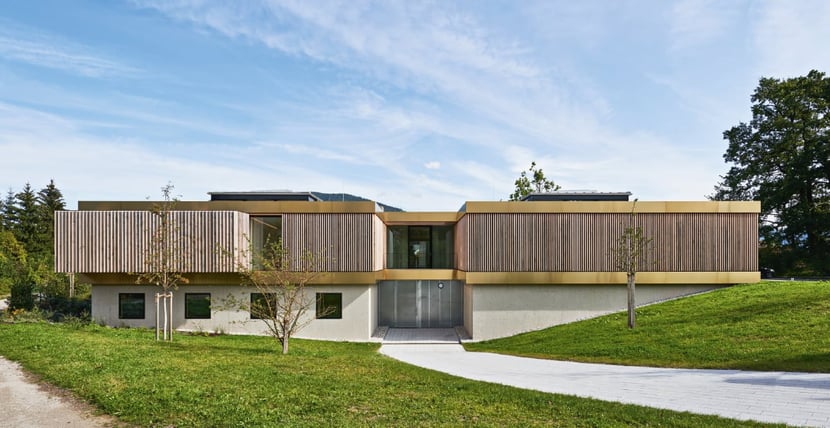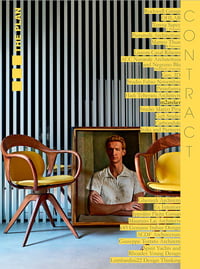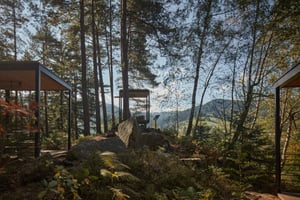Login
Registered users

The new spa in Bad Wiessee, southern Germany, offers guests a psychophysical journey of reconnection with themselves and the environment at a health and wellness retreat surrounded by nature. The Bavarian town on the shores of Lake Tegernsee has been famous for its thermal springs since 1910. The new Jod Schwefelbad facility, which opened in 2020 after nearly two years of construction, was designed by Matteo Thun & Partners, a Milan-based architecture and design firm founded in the 1980s. Led by Matteo Thun and Antonio Rodriguez, the studio operates internationally and specializes in the design of hotels and luxury residences.

The thermal spa takes its name from the elements contained in the local spring water: iodine (Jod) and sulfur (Schwefel), a very rare combination that is particularly efficacious in the prevention and treatment of various diseases.
The design approach is based upon the principles of salutogenesis, according to which people regenerate much better in a pleasant environment. The building offers an area of 1,200 sq. m on two levels, its floor plan divided into four areas, each centered on an atrium with zenithal lighting. The design creates a sequence of environments that progressively leads guests from public to private spaces. The route begins in the entrance courtyard with a water feature, then continues to the reception area and on to distribution areas that offer access to individual treatment rooms. Each cabin contains a tub, a lounger and its own terrace, designed in the style of a Zen garden. The facility draws on 700-m deep underground springs to feed its tubs and inhalation spaces; it also features a dedicated eye-care department. The lower floor offers direct access to the garden and additional rooms dedicated to healing and wellness treatments.

The building dialogues with the surrounding landscape via an internal patio and large windows, fitting harmoniously into its environment through the use of natural materials such as stone and timber. The façade features white fir cladding in a series of vertical panels positioned edgewise to the building’s walls, allowing light to enter while preserving guest privacy. The slats, which will weather to gray over time, are bordered by two horizontal metal bands that run across the top and base. Wood, Matteo Thun’s favorite material, is used in abundance in the interiors, which are dominated by a palette of light colors and characterized by stylistic contaminations of oriental inspiration.

Matteo Thun & Partners’ design brings nature into Jod Schwefelbad’s rooms, flooding guests in a bath of light, water and greenery to create a holistic experience for body and soul. Conceived with sustainability in mind, contact with the outdoors is enhanced through the solutions adopted to ensure environmental comfort. The rooms enjoy indirect natural lighting, while a special ventilation and air conditioning system makes use of night-time air from the nearby mountains.






Location: Bad Wiessee, Germany
Client: Jod-Schwefel-Bad Wiessee
Completion: 2020
Gross Floor Area: 1,350 m2
Architect and Interior Designer: Matteo Thun & Partners
Local Architects: Hirner Riehl Architekten, IMP Ingenieure
Consultants
Landscape: HKK Landschaftsarchitektur, Lex Kerfers Landschaftsarchitekten
Wood: Blaesig Architekten
Photography by Jens Weber, courtesy of Matteo Thun & Partners

Our second special issue dedicated to the contracting world presents a broad selection of projects across a variety of sectors, from hotel to luxury residential, commercial and tertiary. Italian and international architects and designers share their ... Read More

Castello di Casiglio: a health spa with timeless charm
Ceramiche Keope | Gianfranco Lucchesini
Ceramiche Keope supplies porcelain stoneware collections for Castello di Casiglio’s health spa on Lake Como...
LÖYLY
Avanto Architects
The project started from the city of Helsinki initiative. Hernesaari is a former industrial area on the Helsinki seashore that is being developed into...
5 magical ‒ and still secret ‒ places for relaxing with nature
From the mysterious Czech Republic to green Mongolia: inspiration for restorative silence and harmony...